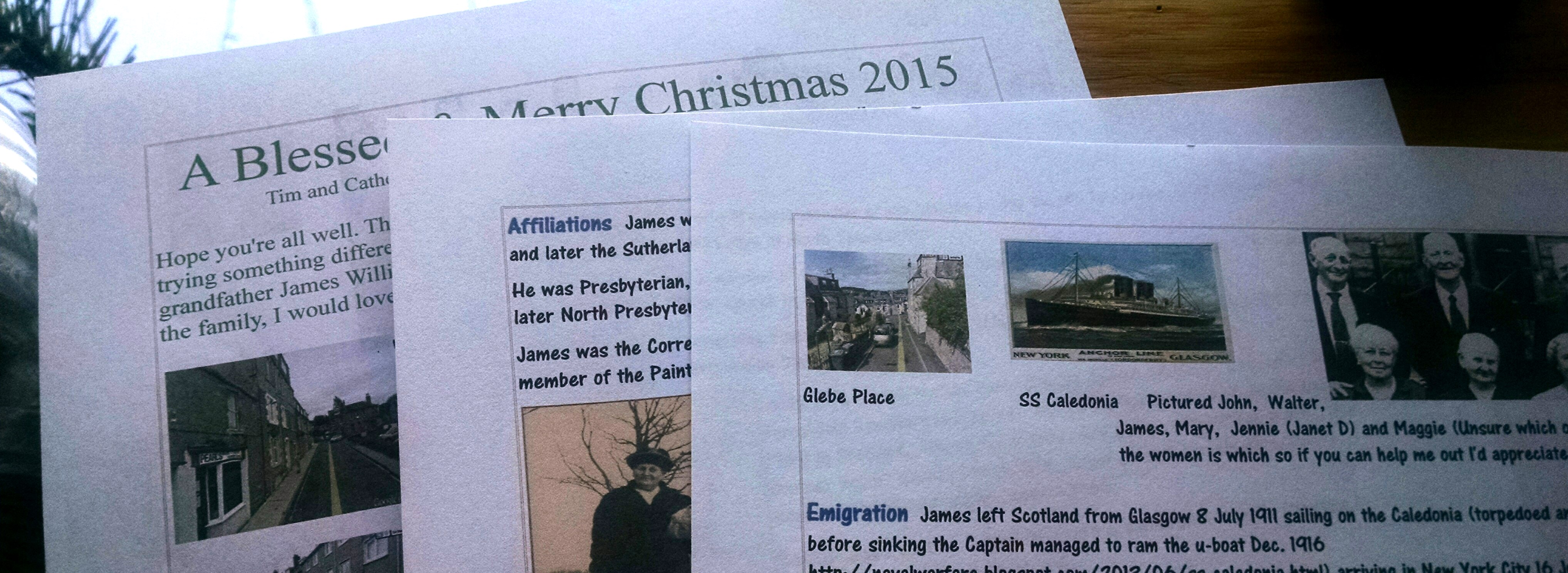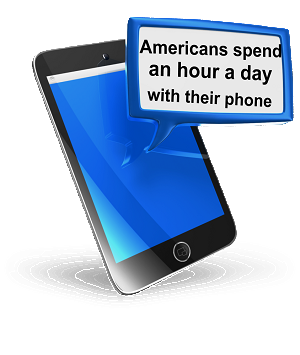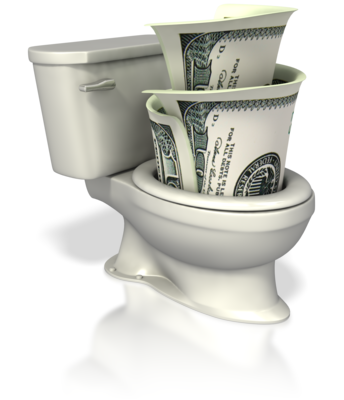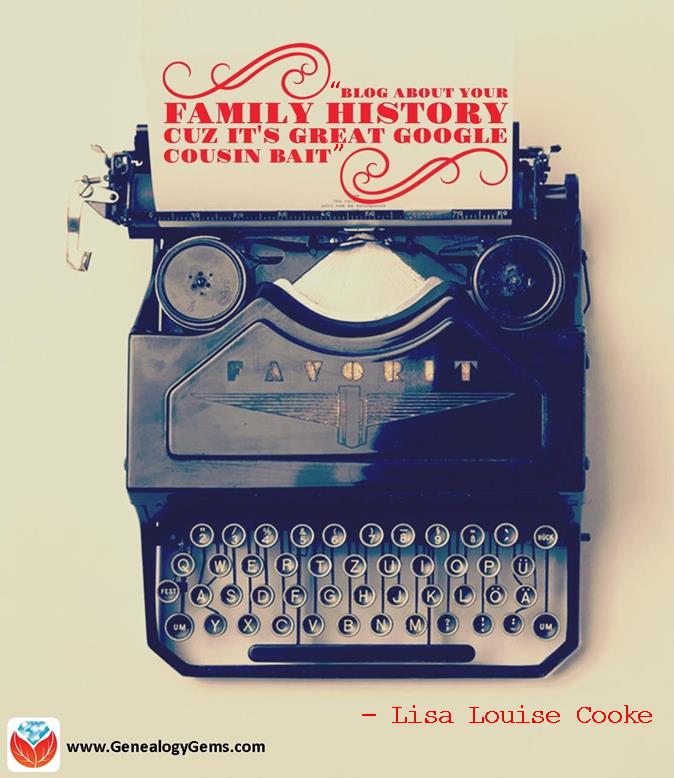Family History in the Annual Christmas Letter? What a Great Idea!
 Why not share the gift of family history story in this year’s Christmas letter or holiday cards?
Why not share the gift of family history story in this year’s Christmas letter or holiday cards?
Genealogy Gems podcast listener Catherine just sent in this fantastic idea about including family history in her annual Christmas letter. I thought I’d share it while it can inspire those whose holiday cards or letters are still on their “to-do” list. (Already done? Think about it for next year!) Here’s what she wrote:
“I’ve always been intimidated by the idea of writing [family history]: where to begin, what to write about, what to include, how to say it. When it was time to sit down and write the family Christmas letter and not having much to report, it struck me. Why not write a family history letter to the cousins about our common maternal Grandfather?
It may not be an original idea but it was new to me, so, deep breath, I took the plunge and the result was a letter that I truly enjoyed writing. I included some fun facts from immigration records and census information, family pictures, a couple of stories and even Google Earth pictures from my Gramp’s birthplace in ‘the Old Country.’ I sourced the letter and added webpage links in case I hooked someone into wanting to know more.”
Thank you Lisa for speaking about Google Earth Pro and my new best friend, Evernote for Genealogy! I can’t wait to see what the family reaction will be. I’m planning some follow up letters and may even go for the big one (gulp)–a blog! I was so inspired I even made two of your wreaths, one for my mother-in-law and one for my best friend, also a genealogy junkie.”
Wow, I love to see how Catherine has taken what I’ve been teaching–from keeping track of sources in Evernote to making wreaths–and RUNNING with it! She says, “Thanks for the great ideas, inspiration and support,” but I want to thank HER for writing in with her enthusiasm and clever ideas. I LOVE the idea of adding the gift of family history–complete with crowd-pleasing Google Earth pictures and proper citations–to your annual Christmas letter. That’s on MY list for next year!
Take These Ideas and Run with Them Yourself with These Helpful How-Tos:
What To Do When Technological Changes Get You Down
Feeling frustrated by changing technology? Here’s a look back at a post I originally wrote in 2013 that addresses the mayhem tech changes can cause, and how a visit to a fast food restaurant changed my perspective on a particularly rough day.
The “Mayhem” commercials from Allstate are a riot, but of course all that mayhem isn’t all that funny when it’s happening to you.
Allstate Raccoon Mayhem Commercial
Sometimes it feels like technology companies are having a little mayhem fun with us when they get us up and running with their software program, or app, or phone, or tablet, or whatever, and then *BAM* they change it all up. Mayhem!
It’s not really that we don’t want new technology, it’s just that:
1. We sometimes get very little if any warning that it’s coming
2. The change requires investing time in learning all new ways to do something.
3. The change seems to be suspiciously benefiting the changer and not us – the “changee.”
4. We have to shift out of auto pilot into manual drive
…which means it takes longer to do tasks, and we tend to make mistakes more often because our brain, our eyes, and our fingers are all trained to quickly complete the task the old way.
I’m usually pretty excited about new technology and I love seeing what it can do for our genealogy efforts, but don’t think that I don’t have my moments when I just want to run screaming into the street and chuck my laptop in the gutter. We all have our moments. And I’m here to tell you that I feel your pain and have suffered myself, some mayhem this week, in fact, I call it:
Mobile Mayhem
See, the thing is, folks love their smart phones. Walt Mossberg, principal technology columnist for The Wall Street Journal just tweeted that according to an Experian marketing survey the average America spends an hour a day with his or her smartphone. And iPhone users spend more time than Android users.
 Google, and specifically YouTube which they own, has definitely taken notice of all this smart phone savvy-ness, and they’ve decided to turn my world, and all the other YouTube Channel publisher’s worlds out there upside down.
Google, and specifically YouTube which they own, has definitely taken notice of all this smart phone savvy-ness, and they’ve decided to turn my world, and all the other YouTube Channel publisher’s worlds out there upside down.
I launched my YouTube channel way back in the stone-age, 2007, before Google even owned YouTube. And I have over 60 videos on the channel, and we’ve been diligently working on getting prepared for a while new phase of video production here at Genealogy Gems. So I have had my hands quite full on the video front.
YouTube has implemented a total redesign of YouTube channel pages. The goal is to make the channels mobile friendly, while still accommodating the wide range of full size computer screens that are out there. But in order to accomplish this, we as channel publishers have to scramble and get new artwork for our banner, produce a new introduction video and rearrange the video layout.
So how did I respond to this change you ask?
I ignored it, of course, until I had about a week left before they were set to flip the switch. And then this week all of a sudden it was an emergency to get my channel ready.
So I finally broke down and hired someone to create the new artwork, then I spent hours one morning trying to get all the changes made. My frustration level was growing a little because I just wasn’t happy with how the design of the new artwork was fitting the new layout. And there were so many other things I wanted and needed to be doing that week.
Then my sweet neighbor came to the door and my dogs, who think every knock on the door is a masked marauder, went totally ballistic, blasting through the room knocking over my morning coffee on their way to the door. So now I had coffee all over the carpet.
After my neighbor left I got the portable steam cleaner out to clean up the coffee stained carpet and it worked for a total of 45 seconds, then dribbled to nothing. So I went to the kitchen and set it on the counter to look at it and when I took the nozzle off it dribbled dirty water all over my freshly cleaned kitchen floor.
I spent the next two hours cleaning the kitchen floor, fixing the steam cleaner nozzle, and cleaning my carpet. And my YouTube channel was still not quite right, and I wasn’t sure how to fix it. Panic started to set in. All of a sudden I feared I would never figure it out, or get it done, and on top of that I was getting further behind on everything else I needed to do.
When my husband got home we went out for fast food because I hadn’t had a chance to do a thing about preparing dinner. So he listened to my day as we go through the line, and then I went to get my soda and I set my tray on the counter by the soda machine. Unfortunately I didn’t notice that the counter top was about six inches shorter than the tray, and my tray of shanghai beef and cream cheese won tons unceremoniously hit the floor.
At this point I was feeling pretty sorry for myself and pretty sure it was all YouTube’s fault.
Then, a woman my age came into the restaurant with her daughter and husband. She sat and waited while they ordered the food because she was in a wheel chair. And needless to say my perspective made a big course correction.
Maybe I don’t really know what frustration can be. And…get ready for it…maybe I over-reacted all day long.
She smiled at me and I smiled back and then I got to thinking back on my day. And I realized it’s so often not the change itself that causes the mayhem, but it’s our knee jerk response of fear to it.
If you have ever found yourself gritting your teeth as the next big technological roll out happens, or sometimes worse yet, the closing of a favorite tool like iGoogle or the Google News Timeline, here are some things to keep in mind:
First: Stay Calm and Carry On
Just like the famous saying from World War II Britain, we are much more effective in difficult times when we take a breath and stay calm, and then we continue moving forward to the best of our ability at our pace.
Often times it’s our lack of calm that causes us not carry on as usual, and in the end, brings more trouble down on our own heads.
The older I get the more I can see how human beings bring a lot of stuff on themselves. I didn’t start picking away at the new artwork and design until the last week before the change implementation because I was focusing on how they shouldn’t be changing it. And yea, that kind of thinking wasn’t hurting anyone but myself, because YouTube wasn’t about to call a halt to it because some channels didn’t like the idea.
And simple things, like I knew better than to set my coffee where I did, but I was so freaked out about the YouTube design I carelessly set it at dog level. And it was just silly to pull the nozzle off the steam cleaner over a clean floor rather than over the sink.
Second: The Technology Folks Probably Have a Good Reason for the Change
Sometimes it’s a financially driven change; they just can’t make it sustainable as is. And I would much rather see an inconvenient change than a complete disappearance of a Google or an Ancestry.
And sometimes it’s because the technology folks do have their eye on the future, and they see the big picture of how you and other users use your technology today. In the end the change will meet a pressing need, and they are striving to stay ahead of the game so we aren’t moaning down the road. YouTube’s change is a great example of that. They’ve made the case that a large percentage of users watch video from mobile devices and they challenged us as channel publishers to check our own analytics. And you know what, they’re right! I wasn’t keeping an eye on that but YouTube was.
Third: A Little Investment in Education can Go a Long Way
It’s OK if you have to slow down for a little while and spend some time getting re-educated. I decided to sign up for an online class YouTube offered channel publishers and in the first hour or so I came to better understand how my channel was going to benefit. And understanding the benefits will give you the motivation to take on the change.
I know, it’s hard to imagine that you can find even more time on education. But as I’ve said before on my Genealogy Gems Podcast, I think as genealogists we need to actually be budgeting a certain amount of time for education. Don’t leave it to be squeezed in in a panic. Allocate 10% of your research time for reading and education, and another 10% on staying organized, and I guarantee you remaining 80% will be much more productive!
The truth is, if my YouTube channel doesn’t look perfect yet, I trust that you guys will still be watching, and it certainly won’t stop me from publishing new videos.
And it’s sort of funny that this has been on my mind so much this week and I’ve been personally facing the YouTube change here at Genealogy Gems, because I just had the opportunity to sit in on a conference call with Ancestry.com where they provided a behind the scenes look at some of the changes they are working on for the upcoming months. Listen to Genealogy Gems Podcast episode 156 to hear the details.
After all I struggled with and all I learned from it last week, I found myself being much more open to the Ancestry changes. I was more focused on spotting the benefits to the genealogist, and I found myself admiring their commitment to continuous improvement. See the thing is, whether you are an individual genealogist or a big company like Ancestry, if you aren’t striving for continuous improvement you will fall behind, and the work will become more difficult because you are working harder than you have to.
We Dig These Gems: New Genealogy Records Online
 We learn about so many fantastic new genealogy records online every week. So each Friday we round up several of them for you to glance through. Watch for databases and documents that your ancestors might appear in–but also watch for the kinds of records that may be out there already, that you haven’t yet looked for. This week: British women in World War I, Polish-American marriages, Irish vital records, Canadian travel photography, Scottish artifacts and documents and a Louisiana (US) press archive.
We learn about so many fantastic new genealogy records online every week. So each Friday we round up several of them for you to glance through. Watch for databases and documents that your ancestors might appear in–but also watch for the kinds of records that may be out there already, that you haven’t yet looked for. This week: British women in World War I, Polish-American marriages, Irish vital records, Canadian travel photography, Scottish artifacts and documents and a Louisiana (US) press archive.
WWI WOMEN. FindMyPast has posted over 9,500 UK records that illustrate the various roles played by woman during the Frist World War. These include:
- Women’s Army Auxiliary Corps Service Records 1917-1920. It’s a relatively small collection but rich in material on each woman.
- British Women’s Royal Naval Service officer files 1917-1919 (ADM 318) details the service history of women who served as officers in the Women’s Royal Naval Service during the First World War.
- British Women’s Royal Naval Service Ratings’ Service Registers 1918-1919 contains the details of nearly 7,000 enlisted women who served as Wrens during the First World War.
- British Women’s Royal Air Force Service Records 1918-1920 is an index of 31,090 Women’s Royal Air Force service records held by The National Archives.
POLISH-AMERICAN MARRIAGES. A new database of Polish-American marriages has been posted by the Polish Genealogical Society of Connecticut and the Northeast.
According to a press release, “This database contains the names of couples of Polish origin who were married in select locations in the Northeast United States. The information was taken from marriage records, newspaper marriage announcements, town reports, parish histories or information submitted by Society members. The time period generally covered by these lists is 1892-1940. It includes the States of Delaware, Massachusetts, New Hampshire, New Jersey, Rhode Island and Vermont. Connecticut and Jersey City, NJ will be added at a later date.”
IRISH BMD. Over a million records appear in a new database of Irish records of the city and county of Derry~Londonderry and Inishowen, County Donegal. Entries span 1642-1922 and include:
- Pre-1922 civil birth and marriage registers,
- Early baptismal and marriage registers of 97 churches,
- Headstone inscriptions from 118 graveyards, and
- Census returns and census substitutes from 1663 to 1901.
Click here to access these records (and other County Derry resources) at RootsIreland,ie (subscription required).
CANADIAN TRAVEL PHOTOGRAPHY. A small but visually rich collection of pictures promoting Canadian tourism is now at Flickr Creative Commons. Use these to explore places your ancestors may have visited (and the images that may have lured them there) if they vacationed by rail in the 1800s or early 1900s. (Click here to learn more about finding great historical photos at Flickr Creative Commons.)
SCOTTISH ARTIFACTS AND DOCUMENTS. A new digital archive at Historic Scotland has launched an online database of 400 artefacts now includes over 400 artifacts important to Scottish history. Everyday household objects, ship models, coins, weaponry, bits ‘n bobs of old homes and buildings, industrial machinery and miscellaneous photos, books and ephemera are all browsable on this site. It’s a great place to look for images that help illustrate your Scottish ancestors’ history.
LOUISIANA PRESS COVERAGE. The Louisiana Digital Media Archive has launched as “the first project in the nation to combine the media collections of a public broadcaster and a state archives,” according to its site description. “This ever-expanding site contains a combined catalog of thousands of hours of media recorded over the past half-century. You can see interviews with Louisiana civil rights pioneers, notable political figures, war heroes, artists and literary icons. You’ll have a front row seat to Louisiana history through video of historic events. You can also visit remote and endangered Louisiana places and cultures.”
 Not sure how to find record sets like these for YOUR family history? Here’s a tip! Set up a Google Alert. Say you want to know whenever new material on Polish-Americans in Detroit is found by Google’s ever-searching search engines. Click here to learn how to set up this search (or any other) Google Alert for genealogy.
Not sure how to find record sets like these for YOUR family history? Here’s a tip! Set up a Google Alert. Say you want to know whenever new material on Polish-Americans in Detroit is found by Google’s ever-searching search engines. Click here to learn how to set up this search (or any other) Google Alert for genealogy.
This tip comes to you courtesy of the book The Genealogist’s Google Toolbox, Second Edition by Lisa Louise Cooke–the fully-revised 2015 edition that’s packed with strategies that will dramatically improve your ability to find your family history online.
What the U.S. Federal Government Could Learn from Genealogists
Beware: Personal Opinions are coming your way in this article!
In my book The Genealogist’s Google Toolbox I emphasize how to use Google to determine what is already available and free online before investing your limited time and money in offline family history searching. Smart genealogists allocate their resources wisely, getting the most bang for their buck. And collaboration between individual genealogists allows us to accomplish even more.
 It looks like the U.S. Federal Government could learn a thing or two from savvy genealogists. The Washington Times is reporting that Congress’s auditor has discovered that our tax payer money given to the federal government isn’t being spent very wisely. (Imagine that!) Agencies fail to collaborate and share information, creating redundancy and overspending.
It looks like the U.S. Federal Government could learn a thing or two from savvy genealogists. The Washington Times is reporting that Congress’s auditor has discovered that our tax payer money given to the federal government isn’t being spent very wisely. (Imagine that!) Agencies fail to collaborate and share information, creating redundancy and overspending.
One example from the article: the Commerce Department “has been charging other government agencies millions of dollars for reports that the other agencies could just as easily have gotten online, for free – often with a Google search.”
This news makes it even harder to swallow the news that the National Archives and Records Administration (NARA) is suffering reduced hours of service due to budgetary issues.
The Bottom Line:
Google Twice, Pay Once (and only if you have to!)

